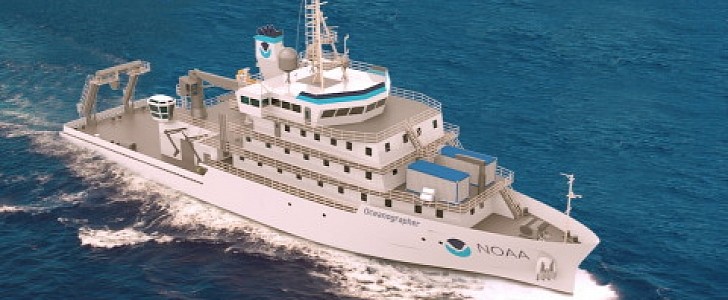We’re witnessing a rise in green alternatives when it comes to the shipping industry and even in the glamorous world of superyachts. It’s only natural that the clean energy wave should also reach vessels that operate in official governmental programs. The National Oceanographic and Atmospheric Administration (NOAA) will soon be working with hybrid research vessels.
The aptly-named Oceanographer and Discoverer are NOAA’s future research ships that will be pioneering in the sense that they will be equipped with diesel-electric propulsion systems. The two ships are being built by Thoma-Sea Marine Constructors, and the innovative propulsion system will be provided by Siemens Energy. In fact, Thoma-Sea Marine is the first shipyard to install the Siemens advanced solution on a ship in the U.S.
The boats will be equipped with the SiSHIP Blue Drive PlusC diesel-electric propulsion system and the BlueVault battery storage solution. The goal is to save fuel and cut CO2 emissions while also reducing engine maintenance costs. This technology is estimated to help save 15,000 gallons (56,780 liters) of fuel per year for each vessel. This will also lead to cutting 5,700 tons of CO2, which Siemens Energy says is the equivalent of planting more than 370,000 trees.
This hybrid technology has already demonstrated its performance, having been integrated on 80 various ships around the world, including an all-electric car ferry and a cruise passenger ferry, considered to be the world’s largest.
NOAA’s future ships will have enough room for up to 28 scientific researchers, with a crew of 20 people. Both the Oceanographer and Discoverer are considered state-of-the-art research platforms that will carry out ocean survey and data collection tasks, as well as climate studies and missions dedicated to the ocean’s ecosystem.
As we know, the deep oceans still remain mysterious, and the rapidly-advancing technology could help scientists expand their understanding of the ocean while also reducing the carbon footprint as much as possible.
The boats will be equipped with the SiSHIP Blue Drive PlusC diesel-electric propulsion system and the BlueVault battery storage solution. The goal is to save fuel and cut CO2 emissions while also reducing engine maintenance costs. This technology is estimated to help save 15,000 gallons (56,780 liters) of fuel per year for each vessel. This will also lead to cutting 5,700 tons of CO2, which Siemens Energy says is the equivalent of planting more than 370,000 trees.
This hybrid technology has already demonstrated its performance, having been integrated on 80 various ships around the world, including an all-electric car ferry and a cruise passenger ferry, considered to be the world’s largest.
NOAA’s future ships will have enough room for up to 28 scientific researchers, with a crew of 20 people. Both the Oceanographer and Discoverer are considered state-of-the-art research platforms that will carry out ocean survey and data collection tasks, as well as climate studies and missions dedicated to the ocean’s ecosystem.
As we know, the deep oceans still remain mysterious, and the rapidly-advancing technology could help scientists expand their understanding of the ocean while also reducing the carbon footprint as much as possible.






